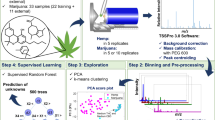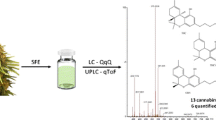Abstract
Cannabis has been cultivated as a source of food, fiber, and medicine globally, so the classification of Cannabis cultivars based on their chemical fingerprints is important to standardize and control the quality of Cannabis, ensure that patients receive a full and consistent spectrum of therapeutic benefits, and promote the further implementation of Cannabis-based products in clinical uses. In this study, a high-throughput analytical method, thermal desorption direct analysis in real time mass spectrometry (TD-DART-MS), was employed to classify various Cannabis hemp cultivars with multivariate analysis. Cannabis plant materials from four cultivars were analyzed directly by TD-DART-MS without solvent extraction. The total run time was 15 min including 8 min for data acquisition and 7 min for cooling down the thermal stage. Data preprocessing strategy such as data transformation was evaluated on the TD-DART-MS data set and cubic root transform has shown significant improvement to the classification. TD-DART-MS data was then processed by principal component analysis (PCA) and the results were compared with those from liquid chromatography-mass spectrometry (LC-MS) data. The samples were clustered based on cultivars by PCA, and the validation samples collected 2 months later were also grouped together with the original samples by cultivars after mean-centering the data sets. Partial least squares discriminant analysis (PLS-DA) models were constructed with the TD-DART-MS data sets and a 99.3 ± 0.3% classification accuracy was obtained from 100 independent bootstrapped Latin partition evaluations. Our results indicate that TD-DART-MS may be used as a screening tool for the classification of Cannabis cultivars.

Graphical abstract







Similar content being viewed by others
References
McPartland JM. Cannabis systematics at the levels of family. Genus, and Species. 2018;3(1):203–12. https://doi.org/10.1089/can.2018.0039.
McPartland JM, Guy GWJTBR. Models of Cannabis taxonomy, cultural bias, and conflicts between scientific and vernacular names. 2017;83(4):327–381. doi:https://doi.org/10.1007/s12229-017-9187-0.
Whiting PF, Wolff RF, Deshpande S, Di Nisio M, Duffy S, Hernandez AV, et al. Cannabinoids for medical use: a systematic review and meta-analysis. JAMA. 2015;313(24):2456–73. https://doi.org/10.1001/jama.2015.6358.
Tanda G, Munzar P, Goldberg SR. Self-administration behavior is maintained by the psychoactive ingredient of marijuana in squirrel monkeys. Nat Neurosci. 2000;3(11):1073–4. https://doi.org/10.1038/80577.
Russo EB. Taming THC: potential cannabis synergy and phytocannabinoid-terpenoid entourage effects. Br J Pharmacol. 2011;163(7):1344–64. https://doi.org/10.1111/j.1476-5381.2011.01238.x.
Small E, Cronquist A. A practical and natural taxonomy for Cannabis. Taxon. 1976;25(4):405–35. https://doi.org/10.2307/1220524.
Hazekamp A, Fischedick JT. Cannabis - from cultivar to chemovar. Drug Test Anal. 2012;4(7–8):660–7. https://doi.org/10.1002/dta.407.
ElSohly MA, Stanford DF, Murphy TP. Chemical fingerprinting of Cannabis as a means of source identification. In: ElSohly MA, editor. Marijuana and the cannabinoids. Totowa, NJ: Humana Press; 2007. p. 51–66.
Jin D, Jin S, Yu Y, Lee C, Chen J. Classification of Cannabis cultivars marketed in Canada for medical purposes by quantification of cannabinoids and terpenes using HPLC-DAD and GC-MS. J Anal Bioanal Tech. 2017;8(1):349.
Citti C, Linciano P, Panseri S, Vezzalini F, Forni F, Vandelli MA, et al. Cannabinoid profiling of hemp seed oil by liquid chromatography coupled to high-resolution mass spectrometry. Front Plant Sci. 2019;10:120. https://doi.org/10.3389/fpls.2019.00120.
Choi YH, Kim HK, Hazekamp A, Erkelens C, Lefeber AWM, Verpoorte R. Metabolomic differentiation of Cannabis sativa cultivars using 1H NMR spectroscopy and principal component analysis. J Nat Prod. 2004;67(6):953–7. https://doi.org/10.1021/np049919c.
Wang X, Harrington PB, Baugh SF. Effect of preprocessing high-resolution mass spectra on the pattern recognition of Cannabis, hemp, and liquor. Talanta. 2018;180:229–38. https://doi.org/10.1016/j.talanta.2017.12.032.
Musah RA, Domin MA, Walling MA, Shepard JR. Rapid identification of synthetic cannabinoids in herbal samples via direct analysis in real time mass spectrometry. Rapid Commun Mass Sp. 2012;26(9):1109–14. https://doi.org/10.1002/rcm.6205.
Lesiak AD, Musah RA, Domin MA, Shepard JR. DART-MS as a preliminary screening method for “herbal incense”: chemical analysis of synthetic cannabinoids. J Forensic Sci. 2014;59(2):337–43. https://doi.org/10.1111/1556-4029.12354.
Lesiak AD, Cody RB, Dane AJ, Musah RA. Rapid detection by direct analysis in real time-mass spectrometry (DART-MS) of psychoactive plant drugs of abuse: the case of Mitragyna speciosa aka “Kratom”. Forensic Sci Int. 2014;242:210–8. https://doi.org/10.1016/j.forsciint.2014.07.005.
Marino MA, Voyer B, Cody RB, Dane AJ, Veltri M, Huang L. Rapid identification of synthetic cannabinoids in herbal incenses with DART-MS and NMR. J Forensic Sci. 2016;61(S1):S82–91. https://doi.org/10.1111/1556-4029.12932.
Gross JH. Direct analysis in real time--a critical review on DART-MS. Anal Bioanal Chem. 2014;406(1):63–80. https://doi.org/10.1007/s00216-013-7316-0.
Harris GA, Fernandez FM. Simulations and experimental investigation of atmospheric transport in an ambient metastable-induced chemical ionization source. Anal Chem. 2009;81(1):322–9. https://doi.org/10.1021/ac802117u.
Sisco E, Forbes TP. Rapid detection of sugar alcohol precursors and corresponding nitrate ester explosives using direct analysis in real time mass spectrometry. Analyst. 2015;140(8):2785–96. https://doi.org/10.1039/c4an02347a.
Barnett I, Bailey FC, Zhang M. Detection and classification of ignitable liquid residues in the presence of matrix interferences by using direct analysis in real time mass spectrometry. J Forensic Sci. 2019;64:1486–94. https://doi.org/10.1111/1556-4029.14029.
Maric M, Marano J, Cody RB, Bridge C. DART-MS: a new analytical technique for forensic paint analysis. Anal Chem. 2018;90(11):6877–84. https://doi.org/10.1021/acs.analchem.8601067.
Sisco E, Verkouteren J, Staymates J, Lawrence J. Rapid detection of fentanyl, fentanyl analogues, and opioids for on-site or laboratory based drug seizure screening using thermal desorption DART-MS and ion mobility spectrometry. Forensic Chem. 2017;4:108–15. https://doi.org/10.1016/j.forc.2017.04.001.
Aloglu AK, Harrington PB, Sahin S, Demir C. Prediction of total antioxidant activity of Prunella L. species by automatic partial least square regression applied to 2-way liquid chromatographic UV spectral images. Talanta. 2016;161:503–10. doi:https://doi.org/10.1016/j.talanta.2016.09.014.
Harrington PB, Laurent C, Levinson DF, Levitt P, Markey SP. Bootstrap classification and point-based feature selection from age-staged mouse cerebellum tissues of matrix assisted laser desorption/ionization mass spectra using a fuzzy rule-building expert system. Anal Chim Acta. 2007;599(2):219–31. https://doi.org/10.1016/j.aca.2007.08.007.
Wang ZF, Chen P, Yu LL, Harrington PD. Authentication of organically and conventionally grown basils by gas chromatography/mass spectrometry chemical profiles. Anal Chem. 2013;85(5):2945–53. https://doi.org/10.1021/ac303445v.
Sigman ME, Williams MR, Castelbuono JA, Colca JG, Clark CD. Ignitable liquid classification and identification using the summed-ion mass spectrum. Instrum Sci Technol. 2008;36(4):375–93. https://doi.org/10.1080/10739140802151440.
Adutwum LA, Abel RJ, Harynuk J. Total ion spectra versus segmented total ion spectra as preprocessing tools for gas chromatography - mass spectrometry data. J Forensic Sci. 2018;63(4):1059–68. https://doi.org/10.1111/1556-4029.13657.
Wang M, Wang YH, Avula B, Radwan MM, Wanas AS, van Antwerp J, et al. Decarboxylation study of acidic cannabinoids: a novel approach using ultra-high-performance supercritical fluid chromatography/photodiode array-mass spectrometry. Cannabis Cannabinoid Res. 2016;1(1):262–71. https://doi.org/10.1089/can.2016.0020.
Acknowledgments
The authors acknowledge IonSense, Inc. for the support and assistance on DART ion source and BioChromato, Inc. for offering IonRocket device for thermal desorption DART-MS experiments.
Funding
Isabella Barnett received support from a MTSU Undergraduate Research Experience and Creative Activity (URECA) grant. This research received additional funding from GreenWay Herbal Products, LLC.
Author information
Authors and Affiliations
Corresponding author
Ethics declarations
Conflict of interest
Elliot Altman has equity ownership in GreenWay Herbal Products, LLC. The other authors declare that they have no conflict of interest
Additional information
Publisher’s note
Springer Nature remains neutral with regard to jurisdictional claims in published maps and institutional affiliations.
Electronic supplementary material
ESM 1
(PDF 194 kb)
Rights and permissions
About this article
Cite this article
Dong, W., Liang, J., Barnett, I. et al. The classification of Cannabis hemp cultivars by thermal desorption direct analysis in real time mass spectrometry (TD-DART-MS) with chemometrics. Anal Bioanal Chem 411, 8133–8142 (2019). https://doi.org/10.1007/s00216-019-02200-7
Received:
Revised:
Accepted:
Published:
Issue Date:
DOI: https://doi.org/10.1007/s00216-019-02200-7




